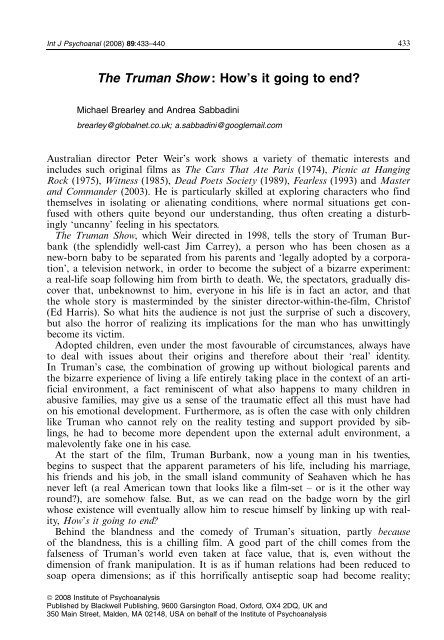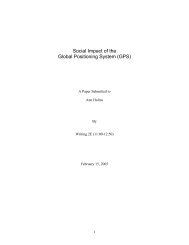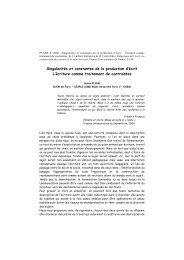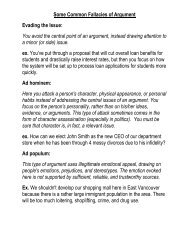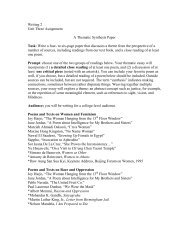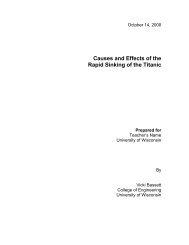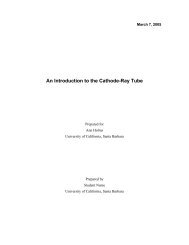The Truman Show: How's it going to end?
The Truman Show: How's it going to end?
The Truman Show: How's it going to end?
You also want an ePaper? Increase the reach of your titles
YUMPU automatically turns print PDFs into web optimized ePapers that Google loves.
Films: <strong>The</strong> <strong>Truman</strong> <strong>Show</strong> 437On the societal level, one might say that mainstream culture t<strong>end</strong>s <strong>to</strong> objectivizethe subject, and that this is shown in allegorical form in the film in Chris<strong>to</strong>f’s objectivizationof <strong>Truman</strong>. <strong>The</strong> film may be taken <strong>to</strong> show how our whole orientation,belief-systems, and life are controlled, lim<strong>it</strong>ed, and made risible or pathetic by asystematic religious ⁄ pol<strong>it</strong>ical mental<strong>it</strong>y of power. <strong>The</strong> ordinary c<strong>it</strong>izen has his subjectiv<strong>it</strong>ywarped and falsified by prevailing powerful unconscious att<strong>it</strong>udes which reside,amongst other places, in the media. <strong>Truman</strong>’s rebellion may thus be seen as therebellion we all need <strong>to</strong> make against a pervasive, globalized, dominating t<strong>end</strong>ency.More fundamentally, <strong>Truman</strong> is upheld in his attempts <strong>to</strong> change and challengethe system by the memory of Sylvia ⁄ Lauren, the young woman who loves him andwho had already made an aborted attempt <strong>to</strong> disillusion him. Her image lies behindhis consistent and increasing efforts <strong>to</strong> get outside the lim<strong>it</strong>s of his world. He buysmagazines in order <strong>to</strong> try <strong>to</strong> reconst<strong>it</strong>ute her face, as if trying <strong>to</strong> firm up his memoryof the good, true object. She represents the good third object who intervenes <strong>to</strong>interrupt a disturbed and pathological dyadic relationship <strong>to</strong> one parent figure – inthis case, a sadistic and controlling one. <strong>The</strong> film adm<strong>it</strong>s of e<strong>it</strong>her of two interpretations,that Chris<strong>to</strong>f may be seen <strong>to</strong> represent an imprisoning mother or a cruel andcontrolling father. <strong>Truman</strong> dreams of <strong>going</strong> <strong>to</strong> Fiji, <strong>to</strong> follow Sylvia where hebelieves she had been dragged <strong>to</strong>. Fiji is also a place which is, as he puts <strong>it</strong> <strong>to</strong> Marlon,‘as far away from here as you can get, before you start coming back’. Itisareal, yet also mythical, place which includes ‘islands w<strong>it</strong>h no people in them’.In other words, <strong>Truman</strong> wants <strong>to</strong> move as far as possible away from his Seahavenworld of falsehood and lies, <strong>to</strong>wards the world of an authentic human being who,loving him for himself, might help him <strong>to</strong>lerate the truth. Or at least <strong>to</strong> a placewhere there might be no people, i.e. no people in on the game or act which weknow – and he <strong>to</strong>o is beginning <strong>to</strong> realize – controls his life.W<strong>it</strong>h his film, Peter Weir gives us an analogy. This is not only a s<strong>to</strong>ry of thefirst person adopted by a TV programme <strong>to</strong> be <strong>it</strong>s unw<strong>it</strong>ting star, or even as<strong>to</strong>ry of the pervasiveness of ‘soap mental<strong>it</strong>y’. It is a s<strong>to</strong>ry of the lim<strong>it</strong>ationsimposed on all of us <strong>to</strong> some extent, and on some of us <strong>to</strong> a much greater andmore damaging extent, when our ‘spontaneous gestures’ are hijacked <strong>to</strong> someoneelse’s <strong>end</strong>s and we are squeezed in<strong>to</strong> – or under in<strong>to</strong>lerable pressure squeezeourselves in<strong>to</strong> – a false mode of being. <strong>The</strong>n we are no longer <strong>end</strong>s in ourselvesbut become means <strong>to</strong> someone else’s <strong>end</strong>s, existing not in our own eyes, bu<strong>to</strong>nly in those of others.Chris<strong>to</strong>f will s<strong>to</strong>p at nothing <strong>to</strong> maintain <strong>Truman</strong>’s prison. <strong>Truman</strong>’s phobias ofdogs and the sea are deliberately and, qu<strong>it</strong>e sadistically, fabricated as a result of theruthless requirement of the crea<strong>to</strong>r and maintainer of the world imposed on <strong>Truman</strong><strong>to</strong> ensure that he stays put; they are not merely allergies <strong>to</strong> the falseness of theenvironment he is forced <strong>to</strong> inhab<strong>it</strong>. In such a context, <strong>The</strong> <strong>Truman</strong> <strong>Show</strong> revealsalso the terrible dilemma for someone exposed <strong>to</strong> such an upbringing: he is forced<strong>to</strong> choose between believing himself or his objects. E<strong>it</strong>her he is mad, or they are.<strong>The</strong> only reassurance they can offer him is a false reassurance; they say, ‘This willpass’, or‘You’re having a breakdown’ (Meryl); or ‘If all this is false, then I’m false<strong>to</strong>o’ (Marlon). <strong>The</strong> shift <strong>to</strong> greater understanding involves <strong>Truman</strong> in increasingvariabil<strong>it</strong>y of his emotional states – from depression, mania, desperation and fury<strong>to</strong> a growing conviction and determination <strong>to</strong> get away, <strong>to</strong> become a true manrather than someone else’s cipher. But … How’s <strong>it</strong> <strong>going</strong> <strong>to</strong> <strong>end</strong>?ª 2008 Inst<strong>it</strong>ute of Psychoanalysis Int J Psychoanal (2008) 89
438 M. Brearley and A. SabbadiniChris<strong>to</strong>f informs us at the beginning of the film: ‘<strong>The</strong>re is nothing fake about<strong>Truman</strong>’. This, however, is not so. Think of the ‘death’ of his ‘father’. <strong>Truman</strong>could never work through <strong>it</strong> properly since in fact <strong>it</strong> never happened. In one sense,<strong>Truman</strong>’s only true relationship is that w<strong>it</strong>h Chris<strong>to</strong>f. Everyone else is an ac<strong>to</strong>r, inon the game. Chris<strong>to</strong>f may be a control-freak and a sadistic tyrant, but at least heis real, and his relationship w<strong>it</strong>h <strong>Truman</strong> takes place in the real world beyond thefantasy land of Seahaven. Only Chris<strong>to</strong>f – and the brief interlopers – speak <strong>to</strong> <strong>Truman</strong>from beyond Seahaven. But until near the very <strong>end</strong>, <strong>Truman</strong> has no knowledgeof Chris<strong>to</strong>f.Towards the <strong>end</strong>, a brief ‘philosophical’ debate takes place between Chris<strong>to</strong>f(a sort of off-Christ figure?) and the heroine who aimed at the truth (Sylvia).Are ‘bread and circuses’ as much as men can <strong>to</strong>lerate? Is happiness merely ahumdrum possibil<strong>it</strong>y, achievable through acceptance and resignation? Is the onlyreal<strong>it</strong>y we can bear that of conform<strong>it</strong>y and obedience? Our pain as viewers is partlya result of our identification w<strong>it</strong>h <strong>Truman</strong>, and part of that pain is our ambivalence,for we <strong>to</strong>o wish <strong>to</strong> be the centre of everyone’s attention. If others watch ourevery move, we may feel paranoid, of course, but we may also feel narcissisticallygratified. In his infantile omnipotence, the child would like his parents <strong>to</strong> watchand admire his every move. So we both long for and hate being watched, being thecentre of everyone’s look.Should we accept the world we are born in<strong>to</strong>, and be content w<strong>it</strong>h the safety of aprotective crea<strong>to</strong>r and maintainer of our s<strong>it</strong>uation? ‘In my world,’ says Chris<strong>to</strong>f <strong>to</strong><strong>Truman</strong> in the last moments of the film, ‘there is nothing <strong>to</strong> fear for you.’ Is thefalse self the best that most of us can achieve? After all, if <strong>Truman</strong> were <strong>to</strong> stayinside the island and inside the false world, all his ordinary needs would be cateredfor: ‘You belong here w<strong>it</strong>h me,’ says Chris<strong>to</strong>f, ‘you can’t leave’. Yet the other side isthe way of truth, involving escape from fals<strong>it</strong>y and from the artificial lim<strong>it</strong>s of animposed world. In the film the lim<strong>it</strong>s are memorably represented as those of a stageset, where the horizons are made of plaster-board. On this side risk is important,since aiming higher means more chance of falling short. For our protagonist there isalso the fear of the unknown, represented by the emptiness beyond the ‘Ex<strong>it</strong>’ door.When <strong>Truman</strong> finally walks in<strong>to</strong> this dark space beyond <strong>it</strong>, the door <strong>it</strong>self is lef<strong>to</strong>pen. Perhaps this gives us a clue <strong>to</strong> the nature of <strong>Truman</strong>’s predicament as opposed<strong>to</strong> that of people who have had less dis<strong>to</strong>rted lives – for him there is no movementbetween real<strong>it</strong>y and falseness, since everything is weighted <strong>to</strong>o heavily on the side ofthe latter. Undoubtedly there were moments of spontane<strong>it</strong>y in his fri<strong>end</strong>ships,his relations <strong>to</strong> his mother, wife and colleagues, but all was so drastically skewed.Another element of risk is the prospect of an unknown self. <strong>The</strong> same argumentis presented in the dialogue, at the <strong>end</strong> of the film, between Chris<strong>to</strong>f and <strong>Truman</strong>;<strong>it</strong> is also present in the opening moments of the film. ‘<strong>The</strong>re is nothing fake about<strong>Truman</strong> himself,’ announces Chris<strong>to</strong>f. <strong>Truman</strong>, gazing in<strong>to</strong> the mirror, speaking <strong>to</strong>himself and <strong>to</strong> the television audience, says: ‘I’m not <strong>going</strong> <strong>to</strong> make <strong>it</strong>. You’re <strong>going</strong><strong>to</strong> have <strong>to</strong> get on w<strong>it</strong>hout me’. Perhaps he is saying that at some level he knowswhat is happening, that his television audience won’t have him for long. Chris<strong>to</strong>fthen speaks of <strong>Truman</strong> as someone who brings comfort <strong>to</strong> millions. <strong>Truman</strong>,perhaps addressing Chris<strong>to</strong>f, perhaps himself, replies: ‘You’re crazy’. To one side,life-lies are the closest <strong>to</strong> truth we need <strong>to</strong> get; <strong>to</strong> the other side, this is madness,something from which one has <strong>to</strong> escape as from psychic death.Int J Psychoanal (2008) 89ª 2008 Inst<strong>it</strong>ute of Psychoanalysis
Films: <strong>The</strong> <strong>Truman</strong> <strong>Show</strong> 439We might also ask if the door marked ‘Ex<strong>it</strong>’ through which <strong>Truman</strong> goes at the<strong>end</strong> of the film, leaving behind the world he had known until then, is in fact death.Does he comm<strong>it</strong> suicide? Winnicott remarks that suicide is one possible outcomefor the false self personal<strong>it</strong>y, even the only way <strong>to</strong> keep the true self safe. In a moremetaphorical sense, though, in the healthiest outcome the old self has <strong>to</strong> be killedoff in order <strong>to</strong> give freedom <strong>to</strong> the true self – not suicide then, but a kind of rebirth(see Milner, 1952).We think similar arguments can come up in relation <strong>to</strong> psychoanalytic practice.Are we always justified in interfering w<strong>it</strong>h our patients’ defences, w<strong>it</strong>h the lies anddeceptions that may have become part and parcel of their ident<strong>it</strong>ies, and have beenput in place <strong>to</strong> deal w<strong>it</strong>h in<strong>to</strong>lerable real<strong>it</strong>ies or prospects? If there is <strong>to</strong>o l<strong>it</strong>tle of asolid kind in place, if there are no good internal objects, no ‘<strong>going</strong> on being’ of atrue self which can have some sense of this being acceptable or bearable, if there is<strong>to</strong>o much hatred or destructiveness – is <strong>it</strong> ethical in such cases <strong>to</strong> begin <strong>to</strong> dismantledefensive systems that have enabled someone <strong>to</strong> get by? Is such an enterpriseat times arrogance, or even cruelty? Are we always <strong>to</strong> take the strenuous and heroicside of the courageous <strong>Truman</strong> himself?Psychoanalysis also parallels the film in other ways. Just as Chris<strong>to</strong>f knows allabout <strong>Truman</strong>, but <strong>Truman</strong> knows nothing of Chris<strong>to</strong>f, so we know a great dealabout our patients while they know much less about us. To some patients this is<strong>it</strong>self a cruel s<strong>it</strong>uation; <strong>it</strong> implies, they feel, that, since we can predict what will happen,we are complic<strong>it</strong> in the intention <strong>to</strong> bring <strong>it</strong> about, and are therefore condemnedas cruel observers or experimenters – and of course psychoanalysts couldget sadistic satisfaction from such power or such knowledge. <strong>The</strong> transference is<strong>it</strong>self a kind of fictional real<strong>it</strong>y, an ‘as-if’ real<strong>it</strong>y available for treatment and help. Butthere is also a real relationship, the one that develops between a patient and anotheradult, the psychoanalyst, who does or does not face up w<strong>it</strong>h appropriate courage orfirmness or tact <strong>to</strong> the demands put upon him. In satisfac<strong>to</strong>ry cases, there is mobil<strong>it</strong>yor fluid<strong>it</strong>y between the two kinds of relationship: the transference can be used,but by the <strong>end</strong> of most sessions there can be some realization of <strong>it</strong>s ‘as-if’ qual<strong>it</strong>y.<strong>The</strong> transference is powerful, but outside and inside the session <strong>it</strong> can be reflectedon and recognized <strong>to</strong> be a part of the patient’s life and relationships in the realworld.We admire Socrates when he suggests we should prefer <strong>to</strong> be dissatisfied humanbeings rather than satisfied pigs; and in <strong>The</strong> <strong>Truman</strong> <strong>Show</strong>, like the televisionviewers w<strong>it</strong>hin the film, we all cheer <strong>Truman</strong> on. We side w<strong>it</strong>h his girlfri<strong>end</strong> andw<strong>it</strong>h his own heroic efforts <strong>to</strong> bow out. We see his panic, suspicions, anger and resolutionas signs of a true self, a healthy disturbance of what would otherwise be ashallow, false-self existence. Like the audience w<strong>it</strong>hin the film, we are relieved a<strong>to</strong>ur hero’s escape from perverse entrapment, including perhaps from our own sadisticand voyeuristic, unconscious att<strong>it</strong>udes <strong>to</strong>wards him. But we may fear for hissan<strong>it</strong>y in the next, imaginary instalment, outside the walls of his false world. How’s<strong>it</strong> <strong>going</strong> <strong>to</strong> <strong>end</strong>?One final thought. Every form of actual psychological abuse has as <strong>it</strong>s correlativea fantasied abuse of the same kind. <strong>The</strong>re are many cases of abuse of children; butwe must accept that many of them may only be imaginary ones. This film suggestsnot only what we know <strong>to</strong> be the case, namely a person’s struggle w<strong>it</strong>h a lifelongsubjection <strong>to</strong> lies and deceptions, but also a parallel case of someone w<strong>it</strong>h paranoidª 2008 Inst<strong>it</strong>ute of Psychoanalysis Int J Psychoanal (2008) 89
440 M. Brearley and A. Sabbadinidelusions of self-reference, like the man one of us met in a mental hosp<strong>it</strong>al whospoke w<strong>it</strong>h admirable san<strong>it</strong>y about everyday matters, except when his voice <strong>to</strong>ok ona conspira<strong>to</strong>rial <strong>to</strong>ne of quiet conviction about the fact, undoubted <strong>to</strong> him, thatevery death in ‘<strong>The</strong> Troubles’ in Northern Ireland occurred because of his ownmurderous wishes or thoughts. In most cases, if a person <strong>to</strong>ld us, as <strong>Truman</strong> ineffect does, that the rain fell only on him, or that like Odysseus he was subject <strong>to</strong> aGod who summoned s<strong>to</strong>rms <strong>to</strong> keep him from escaping, or that his movementswere being mon<strong>it</strong>ored and commented on by invisible watchers whom he couldhear on the car radio, or that traffic jams were especially engineered <strong>to</strong> keep himprisoner, or that his father was drowned <strong>to</strong> induce a phobia of water and thus oftravel in him, we would be right <strong>to</strong> be suspicious of his state of mind. For everycase of a traumatized <strong>Truman</strong>, there must be many whose beliefs and fears areindeed paranoid.ReferencesMahler MS, Pine F, Bergman A (1975). <strong>The</strong> psychological birth of the human infant. London: Hutchinson.Milgram S (1974). Obedience <strong>to</strong> author<strong>it</strong>y: An experimental view. New York, NY: Harper Collins.Milner M (1952). <strong>The</strong> role of illusion in symbol formation. In: <strong>The</strong> suppressed madness of sane men, 88–113.London: Tavis<strong>to</strong>ck, 1987.Thomson D (2002). <strong>The</strong> new biographical dictionary of film, 4th ed<strong>it</strong>ion. London: L<strong>it</strong>tle, Brown.Winnicott DW (1952). Psychoses and child care. In: Winnicott DW. Collected papers: Through paediatrics <strong>to</strong>psycho-analysis, 219–28. London: Tavis<strong>to</strong>ck, 1958.Winnicott, DW (1954). Metapsychological and clinical aspects of regression w<strong>it</strong>hin the psycho-analytical set-up.In: Collected papers: Through paediatrics <strong>to</strong> psycho-analysis, 278–94. London: Tavis<strong>to</strong>ck, 1958.Winnicott DW (1960). Ego dis<strong>to</strong>rtion in terms of true and false self. In: <strong>The</strong> maturational processes and thefacil<strong>it</strong>ating environment, 140–52. London: Hogarth, 1965.Int J Psychoanal (2008) 89ª 2008 Inst<strong>it</strong>ute of Psychoanalysis


